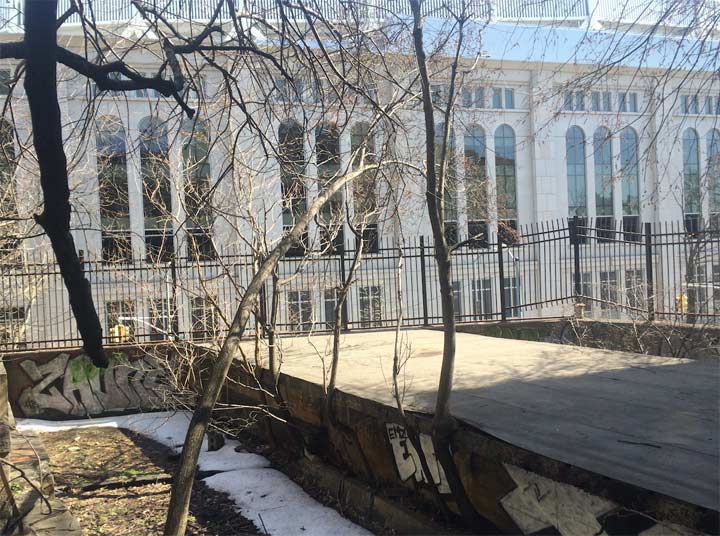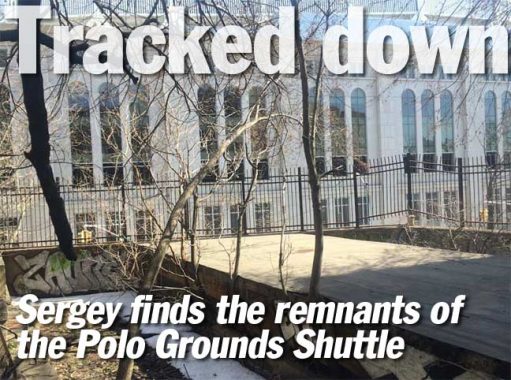By SERGEY KADINSKY
Forgotten New York correspondent
At the southern tip of the ridge that is the Highbridge Heights neighborhood of the Bronx, there is an abandoned subway tunnel that runs for four blocks beneath West 162nd Street. Once a vital link connecting the Ninth Avenue line in Manhattan with the Jerome Avenue line in the Bronx, it was reduced to a three-station shuttle with two-car trains shuttling spectators to games at the Polo Grounds. The 1958 departure of the baseball Giants to San Francisco resulted in the shuttle’s abandonment in August of that year.
Since then, Highbridge residents have had to make a lengthy walk to the nearest subway station while the tunnel became a destination for urban explorers and vagrants. While Forgotten-NY has been to it back in December 1999, I revisited its two former stations and the street running atop the tunnel.

The Jerome-Anderson Avenue station used to straddle above Jerome Avenue. It was demolished nearly a decade after its abandonment. All that is left of it today is a windowless concrete building with an empty platform on its roof. Service below 155th Street-Polo Grounds ended in 1940, and while there was talk of connecting the Polo Grounds Shuttle with the Lenox Avenue subway line, it was the age of highways and this idea was rejected based on its cost.

Looking east in 1999, Kevin Walsh faced Mullaly Park, which was built atop the buried course of Cromwell Creek. In 2017, the New Yankee Stadium faces the former station.
The graffiti on the walls of the former station is ambitious. When no one is chasing them, vandals have time to make elaborate tags that elevate graffiti from a simple tag to a fancy slab of interwoven colors. The portal to the tunnel is blocked by bricks.
1956
2017
On Jerome Avenue, the scenes from 1956 and 2017 hardly have anything in common. The station is gone and where the shuttle ran there is the new Yankee Stadium. A traffic triangle separating Jerome Avenue from the Macombs Dam Bridge approach was given the Greenstreets treatment in the 1990s.
A 1921 Bromley atlas plate shows exactly where the tunnel runs below the street. On the west, the Putnam Branch shared the Putnam Bridge going into Manhattan with the elevated subway line.
A thin black line (signifying an elevated even though the tracks go through a tunnel) marks the course of the shuttle train in this 1945 Hagstrom map. White circles mark stations.
Plenty of photos have been taken of the H. W. Wilson lighthouse from across the Harlem River, but not so many from its Bronx side. Formerly the office of a book publisher, the facility is presently used for self-storage.
Across the street from the lighthouse is an apartment building with Corinthians 6:9 carefully inscribed on its side wall. From a distance it resembles a fading ad. “Neither fornicators nor idolaters nor adulterers nor abusers of themselves with mankind nor thieves nor drunkards nor revilers nor extortioners [sic] shall inherit the kingdom of God.”
At 164th Street and Ogden Avenue is the Taqwa Community Farm, a garden on city-owned land founded by Highbridge resident Abu Talib. It is one of nearly a dozen community gardens in the neighborhood established on vacant land where apartment buildings suffered wholesale abandonment in the 1970s. Taqwa is one of the larger gardens in Highbridge Heights in size and yield, growing 10,000 pounds of produce annually.
The shuttle tunnel runs under West 162nd Street between Ogden and Anderson Avenues.
When looking at what could do done with the abandoned Polo Gounds Shuttle tunnel, it is clear that its revival as a subway line is unlikely with new Yankee Stadium in in the way and the bridge to Manhattan eliminated. Seeing the expansion of parkland in the most unlikely of spaces, the Lowline project of the Lower East Side comes to mind, as it seeks to transform unused trolley tracks at the Delancey-Essex Streets subway station into an underground park.
Why not do the same in Highbridge Heights? A pedestrianized Polo Grounds Shuttle Tunnel would connect Yankee Stadium with the Harlem River and along the way contain artworks and displays relating to its history. One can argue that this neighborhood’s counterpart to Manhattan’s High Line Park is the recently reopened High Bridge path. Transforming the Polo Grounds Shuttle tunnel into an underground park would give The Bronx its own Low Line, giving the borough a unique park experience.
Sergey Kadinsky is the author of Hidden Waters of New York City: A History and Guide to 101 Forgotten Lakes, Ponds, Creeks, and Streams in the Five Boroughs (2016, Countryman Press)
“Comment…as you see fit.”
4/11/17
